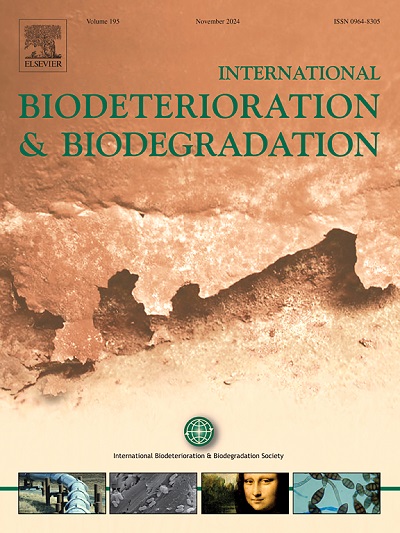Co-biodegradation of cyanide and phenol by Alcaligenes faecalis JF101: Investigating interaction effects
IF 4.1
2区 环境科学与生态学
Q2 BIOTECHNOLOGY & APPLIED MICROBIOLOGY
International Biodeterioration & Biodegradation
Pub Date : 2025-02-01
DOI:10.1016/j.ibiod.2024.105996
引用次数: 0
Abstract
Cyanide and phenol are highly toxic chemicals that exert severe inhibitory effects on microorganisms, posing significant challenges for their removal by biological methods in coexistent systems. In this study, we successfully isolated a bacterial strain named JF101, identified as Alcaligenes faecalis, which was capable of degrading both cyanide and phenol. The interactions between cyanide and phenol during biodegradation were investigated. It was found that the presence of 100 mg/L cyanide significantly enhanced the degradation of phenol, leading to the complete degradation of 1000 mg/L phenol within 86 h. In contrast, only 21.9% of phenol was degraded in the absence of cyanide. Additionally, the presence of phenol had minimal impact on cyanide degradation; a concentration of 100 mg/L cyanide could be rapidly and completely degraded within 40 min even in the presence of up to 1000 mg/L phenol. Five empirical kinetic models of Haldane, Aiba, Edward, Yano, and Webb were employed to describe the degradation processes of phenol and cyanide in both single-substrate and dual-substrate systems. The putative degrading enzymes, degradation products, and pathways associated with the co-degradation of cyanide and phenol were systematically analyzed. The formamide and NH4+-N produced from the rapid degradation of cyanide served as nitrogen sources, facilitating the resumed growth of strain JF101 and enhancing phenol degradation.

粪Alcaligenes faecalis JF101协同生物降解氰化物和苯酚:相互作用效应的研究
氰化物和苯酚是剧毒的化学物质,对微生物有严重的抑制作用,在共存系统中用生物方法去除它们是一个重大挑战。本研究成功分离出一株既能降解氰化物又能降解苯酚的细菌JF101,鉴定为Alcaligenes faecalis。研究了氰化物与苯酚在生物降解过程中的相互作用。研究发现,100 mg/L氰化物的存在显著增强了苯酚的降解,1000 mg/L苯酚在86 h内完全降解,而在没有氰化物的情况下,苯酚的降解率仅为21.9%。此外,苯酚的存在对氰化物降解的影响很小;浓度为100 mg/L的氰化物,即使存在高达1000 mg/L的苯酚,也能在40分钟内迅速完全降解。采用Haldane、Aiba、Edward、Yano和Webb五个经验动力学模型分别描述了单底物和双底物体系中苯酚和氰化物的降解过程。系统分析了氰化物和苯酚共降解过程中可能存在的降解酶、降解产物和降解途径。氰化物快速降解产生的甲酰胺和NH4+-N作为氮源,有利于菌株JF101的恢复生长,增强了对苯酚的降解。
本文章由计算机程序翻译,如有差异,请以英文原文为准。
求助全文
约1分钟内获得全文
求助全文
来源期刊
CiteScore
9.60
自引率
10.40%
发文量
107
审稿时长
21 days
期刊介绍:
International Biodeterioration and Biodegradation publishes original research papers and reviews on the biological causes of deterioration or degradation.
文献相关原料
公司名称
产品信息
阿拉丁
Phenol

 求助内容:
求助内容: 应助结果提醒方式:
应助结果提醒方式:


